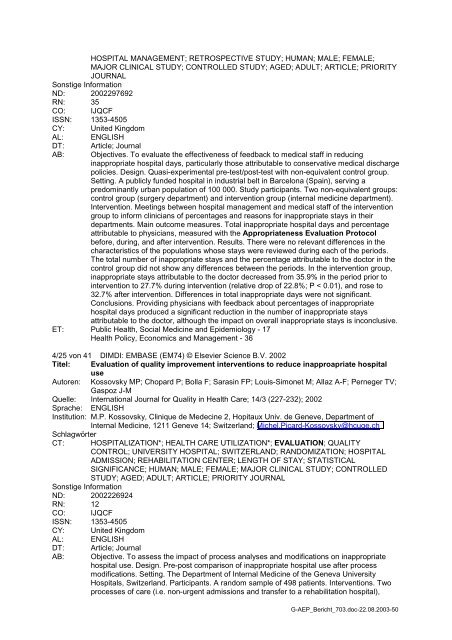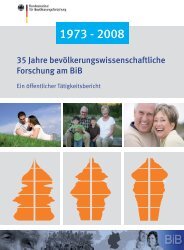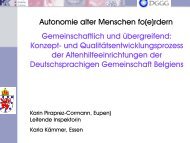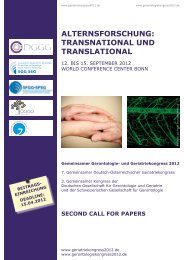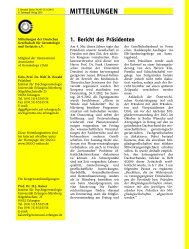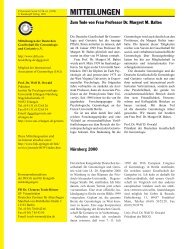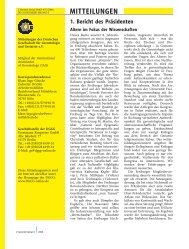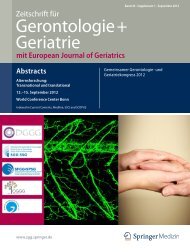G-AEP-Kriterien - Deutsche Gesellschaft für Gerontologie und ...
G-AEP-Kriterien - Deutsche Gesellschaft für Gerontologie und ...
G-AEP-Kriterien - Deutsche Gesellschaft für Gerontologie und ...
Sie wollen auch ein ePaper? Erhöhen Sie die Reichweite Ihrer Titel.
YUMPU macht aus Druck-PDFs automatisch weboptimierte ePaper, die Google liebt.
HOSPITAL MANAGEMENT; RETROSPECTIVE STUDY; HUMAN; MALE; FEMALE;<br />
MAJOR CLINICAL STUDY; CONTROLLED STUDY; AGED; ADULT; ARTICLE; PRIORITY<br />
JOURNAL<br />
Sonstige Information<br />
ND: 2002297692<br />
RN: 35<br />
CO: IJQCF<br />
ISSN: 1353-4505<br />
CY: United Kingdom<br />
AL: ENGLISH<br />
DT: Article; Journal<br />
AB: Objectives. To evaluate the effectiveness of feedback to medical staff in reducing<br />
inappropriate hospital days, particularly those attributable to conservative medical discharge<br />
policies. Design. Quasi-experimental pre-test/post-test with non-equivalent control group.<br />
Setting. A publicly f<strong>und</strong>ed hospital in industrial belt in Barcelona (Spain), serving a<br />
predominantly urban population of 100 000. Study participants. Two non-equivalent groups:<br />
control group (surgery department) and intervention group (internal medicine department).<br />
Intervention. Meetings between hospital management and medical staff of the intervention<br />
group to inform clinicians of percentages and reasons for inappropriate stays in their<br />
departments. Main outcome measures. Total inappropriate hospital days and percentage<br />
attributable to physicians, measured with the Appropriateness Evaluation Protocol<br />
before, during, and after intervention. Results. There were no relevant differences in the<br />
characteristics of the populations whose stays were reviewed during each of the periods.<br />
The total number of inappropriate stays and the percentage attributable to the doctor in the<br />
control group did not show any differences between the periods. In the intervention group,<br />
inappropriate stays attributable to the doctor decreased from 35.9% in the period prior to<br />
intervention to 27.7% during intervention (relative drop of 22.8%; P < 0.01), and rose to<br />
32.7% after intervention. Differences in total inappropriate days were not significant.<br />
Conclusions. Providing physicians with feedback about percentages of inappropriate<br />
hospital days produced a significant reduction in the number of inappropriate stays<br />
attributable to the doctor, although the impact on overall inappropriate stays is inconclusive.<br />
ET: Public Health, Social Medicine and Epidemiology - 17<br />
Health Policy, Economics and Management - 36<br />
4/25 von 41 DIMDI: EMBASE (EM74) © Elsevier Science B.V. 2002<br />
Titel: Evaluation of quality improvement interventions to reduce inapproapriate hospital<br />
use<br />
Autoren: Kossovsky MP; Chopard P; Bolla F; Sarasin FP; Louis-Simonet M; Allaz A-F; Perneger TV;<br />
Gaspoz J-M<br />
Quelle: International Journal for Quality in Health Care; 14/3 (227-232); 2002<br />
Sprache: ENGLISH<br />
Institution: M.P. Kossovsky, Clinique de Medecine 2, Hopitaux Univ. de Geneve, Department of<br />
Internal Medicine, 1211 Geneve 14; Switzerland; Michel.Picard-Kossovsky@hcuge.ch<br />
Schlagwörter<br />
CT: HOSPITALIZATION*; HEALTH CARE UTILIZATION*; EVALUATION; QUALITY<br />
CONTROL; UNIVERSITY HOSPITAL; SWITZERLAND; RANDOMIZATION; HOSPITAL<br />
ADMISSION; REHABILITATION CENTER; LENGTH OF STAY; STATISTICAL<br />
SIGNIFICANCE; HUMAN; MALE; FEMALE; MAJOR CLINICAL STUDY; CONTROLLED<br />
STUDY; AGED; ADULT; ARTICLE; PRIORITY JOURNAL<br />
Sonstige Information<br />
ND: 2002226924<br />
RN: 12<br />
CO: IJQCF<br />
ISSN: 1353-4505<br />
CY: United Kingdom<br />
AL: ENGLISH<br />
DT: Article; Journal<br />
AB: Objective. To assess the impact of process analyses and modifications on inappropriate<br />
hospital use. Design. Pre-post comparison of inappropriate hospital use after process<br />
modifications. Setting. The Department of Internal Medicine of the Geneva University<br />
Hospitals, Switzerland. Participants. A random sample of 498 patients. Interventions. Two<br />
processes of care (i.e. non-urgent admissions and transfer to a rehabilitation hospital),<br />
G-<strong>AEP</strong>_Bericht_703.doc-22.08.2003-50


